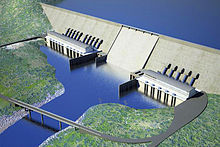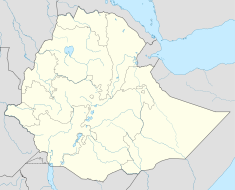- Grand Ethiopian Renaissance Dam
-
Millennium Dam 
Rendition of the damLocation of Millennium Dam Country Ethiopia Location Benishangul-Gumuz Region Coordinates 11°12′51″N 35°05′35″E / 11.21417°N 35.09306°ECoordinates: 11°12′51″N 35°05′35″E / 11.21417°N 35.09306°E Status Preliminary construction Construction began April 2011 Construction cost $4.8 billion USD Owner(s) Ethiopian Electric Power Corp Dam and spillways Type of dam Gravity, roller-compacted concrete Height 145 m (476 ft) Length 1,800 m (5,906 ft) Impounds Blue Nile River Reservoir Creates Millennium Reservoir Capacity 63,000,000,000 m3 (51,074,931 acre·ft) Power station Commission date September 2014 (planned) Turbines 15 x 350 MW Francis turbines Installed capacity 5,250 MW Net generation 15,000 GWh (planned) Website
http://www.grandmillenniumdam.net/The Grand Ethiopian Renaissance Dam ( Amharic: ህዳሴ ግድብ, Hidāse Gēdīb), formerly known as the Millennium Dam and sometimes referred to as Hidase Dam, is an under construction gravity dam on the Blue Nile River about 40 km (25 mi) east of Sudan in the Benishangul-Gumuz Region of Ethiopia.[1] At 5250 MW, the dam will be the largest hydroelectric power plant in Africa when completed, as well as the tenth largest in the world.[2] The reservoir at 63 billion cubic meters will be one of the continent's largest.[3]
Contents
Background
On 31 March 2011, a day after the project was made public, a US$4.8 billion contract was awarded without competitive bidding to Salini Costruttori and the dam's foundation stone was laid on 2 April 2011 by Ethiopia's Prime Minister Meles Zenawi.[4] A rock crushing plant has been constructed along with a small air strip for fast transportation.[5] Construction is expected to last 44 months when two generators would be operational.[6] Egypt, which lies downstream, opposes the dam which it believes will reduce the amount of water that it gets from the Nile.[7] Zenawi argues, based on an unnamed study, that the dam would not reduce water availability downstream and would also regulate water for irrigation.[6] In May 2011, it was announced that Ethiopia would share blueprints for the dam with Egypt so the downstream impact could be examined.[8]
The dam was originally called "Project X" and after its contract was announced, it was called the Millennium Dam.[9] On 15 April 2011, the Council of Ministers renamed it Grand Ethiopian Renaissance Dam.[10]
Design
The dam will be a 145 m (476 ft) tall, 1,800 m (5,906 ft) long gravity-type composed of roller-compacted concrete and will have two power houses, each on either side of the spillway. The right power house will contain ten 350 MW Francis turbine-generators while the left will contain five. Supporting the dam and reservoir will be a 5 km (3 mi) long and 50 m (164 ft) high saddle dam.[3] The dam's reservoir will have a volume of 63,000,000,000 m3 (51,074,931 acre·ft).[4]
Cost and financing
The Ethiopian government has stated that it intends to fund the entire cost of the dam by itself. It has issued a bond targeted at Ethiopians in the country and abroad to that end.[6] The turbines and associated electrical equipment of the hydropower plants costing about US$1.8 billion are reportedly financed by Chinese banks. This would leave US$3 billion to be financed by the Ethiopian government through other means.[11] The estimated US$4.8 billion construction cost, apparently excluding the cost of power transmission lines, corresponds to more than 15% of Ethiopia’s Gross Domestic Product of US$31 billion in 2009.
Construction
The main contractor will be the Italian company Salini Costruttori, which also served as primary contractor for the Gilgel Gibe II, Gilgel Gibe II, and Tana Beles dams. It is expected to consume 100 million quintals of concrete [12], the government has pledged to use only domestically produced concrete.
Benefits
A major benefit of the dam will be hydropower production. The electricity to be produced by the hydropower plant is to be sold in Ethiopia and to neighboring countries including Sudan and possibly Egypt. Selling the electricity from the dam would require the construction of massive transmission lines to major consumption centers such as Ethiopia’s capital Addis Ababa and Sudan’s capital Khartoum, both located more than 400km away from the dam. These sales would come on top of electricity that is expected to be sold from other large hydropower plants that are under construction in Ethiopia, such as Gilgel Gibe III.
The plant load factor of the planned hydropwer plant - the expected electricity production divided by the potential production if the power plant was utilized permanently at full capacity - is only 33% compared to 45-60% for other, smaller hdyropower plants in Ethiopia. Critics conclude that a smaller dam would be more cost-effective.[13]
Environmental and social impacts
No environmental and social impact assessment for the dam has been published so far. It is not clear if one has been undertaken or is underway. This makes it difficult to quantify the positive and negative impacts of the dam. However, a qualitative assessment of the positive and negative social and environmental impacts of the dam is attempted below. Public consultation about dams in Ethiopia is affected by the political climate in the country. The NGO International Rivers reports that “conversations with civil society groups in Ethiopia indicate that questioning the government’s energy sector plans is highly risky, and there are legitimate concerns of government persecution. Because of this political climate, no groups are actively pursuing the issues surrounding hydropower dams, nor publicly raising concerns about the risks. In this situation, extremely limited and inadequate public consultation has been organized” during the implementation of major dams.[14]
Impact on Ethiopia
Since the Blue Nile is a highly seasonal river, the dam would reduce flooding downstream of the dam, including on the 40km stretch within Ethiopia. On the one hand, the reduction of flooding is beneficial since it protects settlements from flood damage. On the other hand, it can be harmful, if flood recession agriculture is practiced in the river valley downstream of the dam since it deprives fields from being watered. The dam could also serve as a bridge across the Blue Nile, complementing a bridge that was under construction in 2009 further upstream.[15] The dam will affect the livelihoods of people living in the area upstream of the dam that will be flooded by the reservoir. The Benishangul-Gumuz Region is not densely settled, with only 12 inhabitants per square kilometer on average, including many nomads.[16]
Impact on Sudan and Egypt
The reservoir volume is about equivalent to the annual flow of the Nile at the Sudanese-Egyptian border (65.5 billion cubic meter). This loss to downstream countries would occur only once and would be most likely be spread over several years while the reservoir fills. However, it will still affect downstream countries in a way that is not negligible. Evaporative losses from the dam’s reservoir will permanently reduce the flow of the Blue Nile. The magnitude of these losses is not known. Ethiopian sources point out that both the area of the reservoir and the evaporation rate will be smaller than for Lake Nasser in Egypt. Ethiopia's Minister of Water and Energy, Alemayehu Tegenu, claims that by storing more water in the reservoir of the Millennium Dam and less water in Lake Nasser, "more than 7.5 billion cubic meters of water could be saved from evaporation".[6] At the same time the hydropower plant would be able to produce more than twice as much electricity as the Aswan High Dam (5,250 MW vs. 2,100 MW). The dam would retain silt. It would thus increase the useful lifetime of dams in Sudan – such as the Roseires Dam, the Sennar Dam and the Merowe Dam – and of the Aswan High Dam in Egypt. The beneficial and harmful effects of flood control would affect the Sudanese portion of the Blue Nile, just as it would affect the Ethiopian part of the Blue Nile valley downstream of the dam.[17] Nevertheless, Sudan and Egypt have serious concerns about the project; Egypt has requested that it be allowed to inspect the dam, in order to allay its fears, but Ethiopia has denied the request unless Egypt relinquishes its veto on water allocation.[18] Egypt then consented to it after a delegation reviewed the plans. Ethiopian Foreign Minister Hailemariam Desalegn reportedly danced to mark the occasion.[19]
There is no international treaty for the sharing of the waters of the Blue Nile between Ethiopia on the one hand and Sudan and Egypt on the other hand. A 1959 Nile treaty between Egypt and Sudan does not include Ethiopia. A Nile treaty signed by the upper riparian states in 2010, the Cooperative Framework Agreement, has not been signed by either Egypt or Sudan.[20] The Nile Basin Initiative provides a framework for dialogue among all Nile riparian countries.
References
- ^ "Ethiopia’s biggest dam to help neighbours solve power problem". News One. 17 April 2011. http://www.inewsone.com/2011/04/17/ethiopias-biggest-dam-to-help-neighbours-solve-power-problem/43904. Retrieved 17 April 2011.
- ^ "Ethiopia lays foundation for Africa’s biggest dam". ERTA News. 2 April 2011. http://www.ertagov.com/erta/erta-news-archive/38-erta-tv-hot-news-addis-ababa-ethiopia/574-ethiopia-lays-foundation-for-africas-biggest-dam.html. Retrieved 19 April 2011.
- ^ a b "Salini will build the biggest dam in Africa". Salini Construttori. 31 March 2011. http://www.salini.it/index.php/english/content/show_news/77. Retrieved 17 April 2011.
- ^ a b "Ethiopia Launched Grand Millennium Dam Project, the Biggest in Africa". Ethiopian News. 2 April 2011. http://www.ethiopian-news.com/ethiopia-launched-grand-millennium-dam-project-the-biggest-in-africa/. Retrieved 17 April 2011.
- ^ Belete, Pawlos. "Great Millennium Dam moves Ethiopia". Capital Ethiopia. http://www.capitalethiopia.com/index.php?option=com_content&view=article&id=14459:great-millennium-dam-moves-ethiopia&catid=12:local-news&Itemid=4. Retrieved 19 April 2011.
- ^ a b c d "Meles Launches Millennium Dam Construction on Nile River". New Business Ethiopia. 2 April 2011. http://www.newbusinessethiopia.com/index.php?option=com_content&view=article&id=466:meles-launches-millennium-dam-construction-on-nile-river&catid=35:trade&Itemid=12. Retrieved 19 April 2011.
- ^ "Egypt Stays Opposed to Ethiopia’s Grand Millennium Dam Project". EZega. 11 April 2011. http://www.ezega.com/News/NewsDetails.aspx?Page=heads&NewsID=2847. Retrieved 19 April 2011.
- ^ "Egypt approves of Ethiopia’s Renaissance Dam in principle". Ethiopia News. 16 May 2011. http://www.ethiopian-news.com/egypt-approves-ethiopia%E2%80%99s-renaissance-dam-principle/. Retrieved 29 May 2011.
- ^ "A Nation Rallies Behind a Cause". Grand Millennium Dam. http://grandmillenniumdam.net/a-nation-rallies-behind-a-cause/. Retrieved 29 May 2011.
- ^ "Council of Ministers Approves Regulation Establishing Council on Grand Dam". Ethiopian Government. 16 April 2011. http://webcache.googleusercontent.com/search?q=cache:4e24qPGA8hgJ:www.ena.gov.et/EnglishNews/2011/Apr/16Apr11/138447.htm+http://ena.gov.et/EnglishNews/2011/Apr/16Apr11/138447.htm&cd=1&hl=en&ct=clnk&source=www.google.com. Retrieved 29 May 2011.
- ^ The Economist:The River Nile:A dam nuisance. Egypt and Ethiopia quarrel over water, April 20, 2011, Retrieved on April 24, 2011
- ^ http://www.thereporterethiopia.com/news/309-news/1725-100-mln-quintals-of-cement-required-for-great-ethiopian-renaissance-dam.html
- ^ Beyene, Mehari (14). "How efficient is The Grand Ethiopian Renaissance Dam?". International Rivers. http://www.internationalrivers.org/files/Ethiopiadamefficiency.pdf. Retrieved 23 July 2011.
- ^ International Rivers: What Cost Ethiopia’s Dam Boom?, February 2008, p. 13-14, Retrieved on April 25, 2011
- ^ Daily Ethiopia:Longest Ever Bridge In Ethiopia Under Construction, December 31, 2009, Retrieved on April 25, 2011
- ^ See population density figures shown in Regions of Ethiopia.
- ^ "The dam speech". Grand Millennium Dam. 2 April 2011. http://grandmillenniumdam.net/the-dam-speech/. Retrieved 26 April 2011.
- ^ "Ethiopia won't allow inspection of dam, but ready to negotiate with post-Mubarak Egypt". Almasry Alyoum. 23 April 2011. http://www.almasryalyoum.com/en/node/409918. Retrieved 27 April 2011.
- ^ http://www.ethiofact.com/index.php/ethiopian-news/ethiopian-news/3080-ethiopias-fm-performs-dance-to-honor-egyptian-revolution-
- ^ Ashenafi Abedje, Voice of America:Nile River Countries Consider Cooperative Framework Agreement, March 18, 2011
Categories:- Dams in Ethiopia
- Dams under construction
- Proposed hydroelectric power stations
Wikimedia Foundation. 2010.

